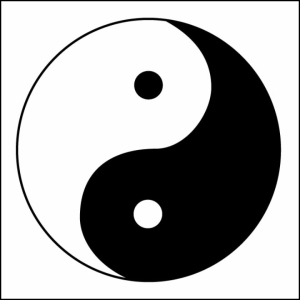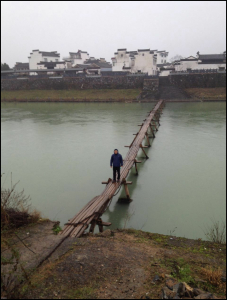Shoulder Exercises: The Yin and the Yang
 Nothing is static; nothing is absolute. Pieces make up the whole; equilibrium of the whole is harmony. For every force, there is an equal and opposite force.
Nothing is static; nothing is absolute. Pieces make up the whole; equilibrium of the whole is harmony. For every force, there is an equal and opposite force.
The shoulder is the most mobile of all the joints in the body. Mobility is sacrificed for stability. The hip, while being much less mobile , is in turn much more stable. These exemplify the opposites of the Yin and the Yang. Power muscle groups that move the shoulder do not provide stability; stabilizing muscle groups for the shoulder do not provide power. For a comprehensive shoulder exercise program, it is necessary to address BOTH the power and the stabilizing muscle groups. An understanding of the functional anatomy of the shoulder will shed light on this paradox.
A true ball-and-socket joint is comprised of a ball shaped head of a bone that is encased within a bony socket (as demonstrated by the femoral head oying-yangf the hip bone within the bony socket of the pelvis). The bony socket provides rigid and stable restraint against dislocation. Although categorized as a “ball-and-socket” joint, the shoulder is far from this type of joint. The shoulder joint is formed between the hemispherical ball shaped humeral head at the top of the arm bone articulating against the saucer-like receiving part (the glenoid) of the shoulder blade bone (the scapula). The size of the humeral head is three to four times the surface area of the glenoid fossa , which means only about 25% of the humeral head is in contact with the glenoid at any time. Without a circumferential bony-socket capture, this is not a true ball-and-socket joint. The structure of the shoulder joint is more aptly described as a golf ball on a tee. Just as the golf ball can easily be toppled off the tee, so does the humeral head easily may shift away, subluxate, off the joint if it were not for soft tissue restraints surrounding the shoulder joint.
There are two types of soft tissue support for the shoulder joint – the static and the dynamic. Static supporting tissues do not contract, while the dynamic supporting tissues do. The static ones are the capsule and the labrum (a small thickened raised edge of fibrocartilaginous tissue surrounding the periphery of the glenoid that slightly deepens the face of the relatively flat glenoid). These offer only minimal support and only at extreme ranges of shoulder motion. The quintessential supporting structure for the shoulder joint comes from the dynamic structures of the surrounding rotator cuff muscles and their tendons. The rotator cuff stabilizes the shoulder joint by dynamically contracting its muscles and compress the humeral head against the glenoid during all phases of shoulder motion. This joint concavity compression force maintains the position of the humeral head against the glenoid and permits motion of the arm around this point of pivot. You can imagine this phenomenon like a suction device on the golf tee sucking the golf ball down to secure it and preventing the ball from toppling over. Only when the humeral head is effectively stabilized against the glenoid can any efficient movement in the shoulder occur. Ineffective joint compression force will permit subluxation of the humeral head off the surface of the glenoid during movements of the shoulder. This causes micro-trauma against the labrum leading to a vicious cycle of further instability, labral tears, and tensile failure of the rotator cuff tendon. Eventually, this leads to frank rupture of the rotator cuff tendon, pain, weakness, and lastly, arthritis of the shoulder joint.
More than 90% of all shoulder exercises focus on strengthening of the large power muscle groups such as the deltoid, pectorals and latissimus. In comparison to the larger muscles, these lifting programs provide minimal strengthening at the rotator cuff level.
 For every force, there is an equal and opposite force. When pushing a weight (such as a barbells) away from the shoulder, that weight is also yin-yang-2pushing an equal and opposite force against the shoulder. When the gleno-humeral joint compression force is strong, the power muscles will be able to push the weight away. However, if the joint compression force is insufficient, as in a weakened rotator cuff muscle, the weight of the barbell will overwhelm the shoulder and result in shoulder subluxation, which is the most common cause of injury in the shoulder among weight lifters.
For every force, there is an equal and opposite force. When pushing a weight (such as a barbells) away from the shoulder, that weight is also yin-yang-2pushing an equal and opposite force against the shoulder. When the gleno-humeral joint compression force is strong, the power muscles will be able to push the weight away. However, if the joint compression force is insufficient, as in a weakened rotator cuff muscle, the weight of the barbell will overwhelm the shoulder and result in shoulder subluxation, which is the most common cause of injury in the shoulder among weight lifters.
Shoulders blow out, just like race cars can skid out. The race car has an extremely powerful engine, however skidding occurs due to lack of grip in the tires. Shoulders blow out, not due to weakness of the power muscles, but fail when the smaller rotator cuff muscles do not stabilize the joint. Rotator cuff specific exercises are necessary to strengthen these smaller stabilizing muscles in order to maintain effective joint compression force during weight lifting exercises.
The literature is replete with all types of rotator cuff strengthening techniques. In general, they are all variations of four motions — front-to-back row, external rotation, internal rotation, and external rotation with the arm abducted at horizontal. Although termed “rotation”, these exercise movements are linearly based concentric contractions working on one muscle group at a time only. The movements are more “linear” than “rotational” since they only move along the line of a short arc and do not complete a 360 degree rotation, which really has to involve circumstantially all muscles surrounding the joint. A more effective and efficient , truly rotational, training technique can be achieved via the ShoulderSphere training program. This rotationally based training technique trains all the rotator cuff muscles simultaneously and three dimensional. In order to make the ball spin within the sphere, opposing muscles have to rapidly contract and relax in a well-coordinated and sequential manner. Clockwise or counterclockwise movement makes no difference since only the sequence of muscular contraction differs. Contraction occurs either at the start of the rotation or at the end of the rotation.
The amount of weight being lifted and/ or how fast the shoulder moves are directly related to the importance of a well-conditioned rotator cuff. Muscle strength mismatch between small rotator cuff muscles and large power muscles is the root of all shoulder injuries.
The Yin and the Yang of shoulder exercise — strengthen both the large power and the small stabilizer muscles for a comprehensive workout. The more powerful the engine, the better the tire is needed to grip the road.